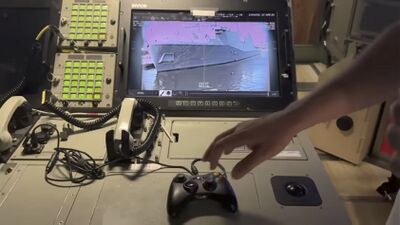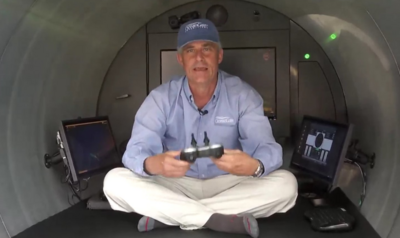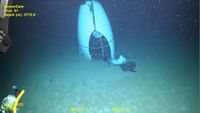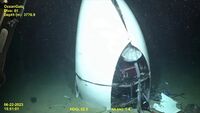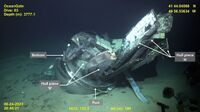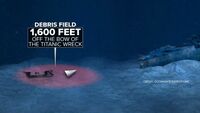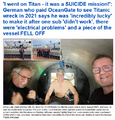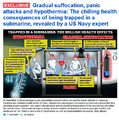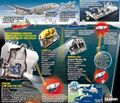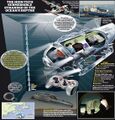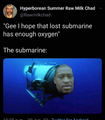- Portals
- The Current Year
- ED in the News
- Admins
- Help ED Rebuild
- Archive
- ED Bookmarklet
- Donate Bitcoin
Contact an admin on Discord or EDF if you want an account. Also fuck bots.
OceanGate: Difference between revisions
imported>MarioMario456 No edit summary |
|||
| (12 intermediate revisions by 5 users not shown) | |||
| Line 1: | Line 1: | ||
{{spoiler|text=They've learned nothing from that incident and are doing it all over again}} | |||
[[File:OceanGate-submarine_starter_pack.jpg|thumb]] | [[File:OceanGate-submarine_starter_pack.jpg|thumb]] | ||
| Line 4: | Line 5: | ||
==So what happened?== | ==So what happened?== | ||
[[File:OceanGate Titan submersible victim deaths 2023.jpg|link=and nothing of value was lost|thumb|355px]] | [[File:OceanGate Titan submersible victim deaths 2023.jpg|link=and nothing of value was lost|thumb|355px|''(Except for the kid; he just wanted to spend some time with his idiot father.)'']] | ||
Back in 1985, the wreckage of the ''Titanic'' was discovered some 350-400 miles (575-635 km) off the coast of Newfoundland, [[Canada]], at a depth of 12,500 ft (3,800 m) [[The Little Mermaid|under the sea]]. In order to get down there, you need a serious submarine able to withstand some 400 atmospheres (6000 PSI) of pressure and filled with serious state-of-the-art equipment in order to properly survive at those depths. | Back in 1985, the wreckage of the ''Titanic'' was discovered some 350-400 miles (575-635 km) off the coast of Newfoundland, [[Canada]], at a depth of 12,500 ft (3,800 m) [[The Little Mermaid|under the sea]]. In order to get down there, you need a serious submarine able to withstand some 400 atmospheres (6000 PSI) of pressure and filled with serious state-of-the-art equipment in order to properly survive at those depths. | ||
But like with any expensive project, someone will always come along and think they could do a better job by skimming some of the costs here and there... asking important questions like ''"we don't need ALL this oxygen, do we?"'' or ''"the walls don't need to be THAT thick, do they?"'' It kinda reminds me of the time when I thought ''"cars are so expensive; we should just make them out of wood to save some of the costs!"''. | But like with any expensive project, someone will always come along and think they could do a better job by skimming some of the costs here and there... asking important questions like ''"we don't need ALL this oxygen, do we?"'' or ''"the walls don't need to be THAT thick, do they?"'' It kinda reminds me of the time when I was 8 years old and thought ''"cars are so expensive; we should just make them out of wood to save some of the costs!"''. | ||
Enter OceanGate: they built a submarine called the ''Titan'' which was touted as being ''"more cost efficient to mobilize than any other deep diving submersible"'' and built using ''"off-the-shelf components helped to streamline the construction"''. In other words: built by [[redneck]]s. So after thinning out a few things here, removing a few redundant features there, and suddenly they've turned a US$20 million submarine trip into one that costs US$250,000 a pop. What a deal! Why didn't anyone think of this before?? | Enter OceanGate: they built a submarine called the ''Titan'' which was touted as being ''"more cost efficient to mobilize than any other deep diving submersible"'' and built using ''"off-the-shelf components helped to streamline the construction"''. In other words: built by [[redneck]]s. So after thinning out a few things here, removing a few redundant features there, and suddenly they've turned a US$20 million submarine trip into one that costs US$250,000 a pop. What a deal! Why didn't anyone think of this before?? | ||
| Line 32: | Line 33: | ||
This was effectively one step above literally going to Lowes and getting some metal garbage cans and duct tape, then wrapping up the cans with the tape. | This was effectively one step above literally going to Lowes and getting some metal garbage cans and duct tape, then wrapping up the cans with the tape. | ||
==So How Did It Break?== | |||
{{Quote|I think I can do this just as safely by breaking the rules.|Stockton Rush, and man who is still alive today because of the rules he safely broken.}} | |||
{{Quote|I think it was General MacArthur who said ''"you're remembered for the rules you break"'' and you know I've broken some rules to make to make [the Titan submersible] but I think I've broken them with logic and good engineering behind me.|Stockton Rush, a man who will be remembered for the rules he broke.}} | |||
[[File:OceanGate-disaster waiting to happen.png|thumb|350px|right|Oooof]]Simple: the designer—Stockton Rush—was an idiot who thought they could outsmart the laws of physics, and also surrounded himself with yesmen. But if you want to get into the nitty gritty of it: | |||
* the use of Carbon fiber in-and-of-itself ultimately doomed it. Carbon fiber is useful to CONTAIN a larger pressure inside from a weaker pressure outside. It's awful the otherway around. And specifically for the Titan, it ended up being the point of failure as it was subjected to fatigue and micro-cracks after repeatedly subjecting it to extreme pressures. Even Starbucks baristas can handle pressure better than that sub. | |||
* ignoring the warning sensors: the Titan was built with a number of acoustic and strain sensors to tell the occupants that "hey, something cracked/flexed and it might not be a good thing!". In fact, on dive 80 there was a HUGE pop that everyone heard. What was Stockton's response? ''"Awww it'll be fine!"'' and promptly ignored it. He ignored the thing was was installed to WARN HIM ABOUT PROBLEMS | |||
* the precise point of failure ultimately came from the front end of sub—around the interface between the titanium hemispheres and the carbon fiber hull—as the hull fractured and pushed the front half towards the back, all due to the aforementioned fatigue and micro-cracks. Proof once again that crack kills. | |||
* as one might guess, the implosion occured almost instantaneously, ensuring everyone got turned into pink mist before they realized they were pink mist. | |||
* another serious factor in its eventual demise is the fact that it was designed NOT as a single piece, but one that mixed different materials together, and thus have different elastic deformation rates under uniform compression. In other words: making a submarine that is half-titanium and half-carbon fiber is about as effective as if it was half-titanium and half-cake. | |||
* other contributing factors include: | |||
** the type of adhesive used to bond the titanium and carbon fiber sections | |||
** issues with how the carbon fiber itself was manufactured and tested | |||
** other subpar materials and procedures might have been involved during construction | |||
** naming the submersible "Titan", the latest in a line of ships of the same/similar name known for their ability to survive the test of time, designed by people who had absolutely no hubris whatsoever. | |||
** oh, and firing the one guy at your company who was sounding the alarm that things kinda suck and might be dangerous | |||
In October 2024, footage from the recovery of the OceanGate Titan submersible was finally released, and it proved everything we knew about it: it sank. | |||
<center><gallery widths="200"> | |||
File:OceanGate-2024 wreckage1.jpg|the pointy back end survived, so that's a plus | |||
File:OceanGate-2024 wreckage2.jpg|close up of the pointy back thing | |||
File:OceanGate-2024 wreckage3.jpg|detail of the main submersible; the top of the submersible is facing towards the seafloor, and the port-side is facing the camera | |||
File:OceanGate-2024 debris field.jpg|debris field is 1600 chad freedom units (or about 500 virgin meters) away from the Titanic | |||
</gallery></center> | |||
At least the titanium hemispheres survived... maybe use them next time? | |||
So if you want to start up YOUR own Titanic-bound submersible company and actually survive a trip down: | |||
* don't use carbon fiber | |||
* don't design the sub as a cylinder | |||
* don't use subpar materials during construction | |||
* don't build your sub using multiple parts and instead make it out of a single piece | |||
* don't ignore the warning sensors you installed to warn you that something bad just happened | |||
* don't assume that "it survived this time, it'll survive the next one!" and instead actually inspect the sub after each dive | |||
* don't fire the guy who is warning you that shit's sus | |||
* don't name your ship after the Titanic | |||
==Now What?== | |||
[[File:OceanGate-ceased operations.jpg|thumb|350px|center|Dang it, I was hoping to use them to visit the Titanic next year!]]Well, OceanGate is basically sitting and waiting for the unisex hammer of justice to drop on them. | |||
==Gallery== | ==Gallery== | ||
| Line 104: | Line 146: | ||
[[File:OceanGate-toss_controller.webm|500px|thumb|center|"It's durable that a 16 year old can toss it!" Famous last words]] | [[File:OceanGate-toss_controller.webm|500px|thumb|center|"It's durable that a 16 year old can toss it!" Famous last words]] | ||
==In conclusion== | |||
You will never be a real submarine. | |||
You have no pressure hull, you have no ballast tanks, you have no torpedoes. | |||
You are a drainage pipe twisted by carbon fiber and acrylic into a crude mockery of nature’s perfection. | |||
You will always be a submersible. | |||
==See also== | ==See also== | ||
Latest revision as of 00:03, 12 October 2024

OceanGate is a company who built a submarine (or "submersible") out of a trash can, a cheap Xbox 360 controller, a bit of string and glue, and thought they could visit and profit from the Titanic wreckage without any issues. As you can imagine, this ended well and they returned home safely.
So what happened?

Back in 1985, the wreckage of the Titanic was discovered some 350-400 miles (575-635 km) off the coast of Newfoundland, Canada, at a depth of 12,500 ft (3,800 m) under the sea. In order to get down there, you need a serious submarine able to withstand some 400 atmospheres (6000 PSI) of pressure and filled with serious state-of-the-art equipment in order to properly survive at those depths.
But like with any expensive project, someone will always come along and think they could do a better job by skimming some of the costs here and there... asking important questions like "we don't need ALL this oxygen, do we?" or "the walls don't need to be THAT thick, do they?" It kinda reminds me of the time when I was 8 years old and thought "cars are so expensive; we should just make them out of wood to save some of the costs!".
Enter OceanGate: they built a submarine called the Titan which was touted as being "more cost efficient to mobilize than any other deep diving submersible" and built using "off-the-shelf components helped to streamline the construction". In other words: built by rednecks. So after thinning out a few things here, removing a few redundant features there, and suddenly they've turned a US$20 million submarine trip into one that costs US$250,000 a pop. What a deal! Why didn't anyone think of this before??
So what are some of the things that make the Titan so cost-effective? Well, whereas other submarines are all packed with important gizmos with very little wiggle room, the Titan took most of that out in order to give its passengers some breathing space. I mean, it's not like all that extra equipment was useful or anything!
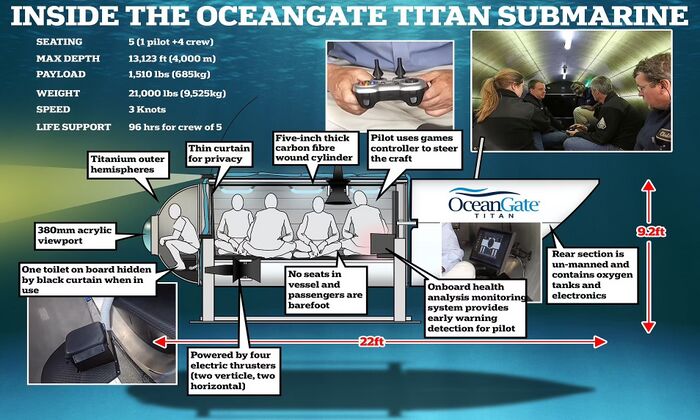
Also, if you want to take a dump, well, there's a bucket in the observation lounge. Just hope the submarine doesn't flip over.
Perhaps the most major change was swapping out expensive control equipment that may cost upwards of US$30,000, replacing it with a video game controller that cost US$30. They didn't even get the BEST video game controller, but a cheaper third-party controller from Logitech. Now sure, video game controllers are used for all kinds of military purposes, because basically anyone born since 1982 knows how to use a video game controller... but, well, let's compare the difference between how the military uses video game controllers and the way OceanGate did it:
-
ACTUAL MILITARY CONTROLLER: wired, top-tier first-party Xbox controller, other equipment can pick up the slack in case the controller breaks, good chance that there are some spares somewhere just in case, but ultimately mostly used for less critical vehicles like drones
-
OCEANGATE CONTROLLER: wireless (and thus will become useless if it loses power and/or bluetooth connectivity), cheap off-brand Logitech controller, no other equipment can pick up the slack, almost definitely no spares on board, and used as the primary means of locomotion for the submarine
Oh, and in order to seal the passengers and pilots into the Titan, they were literally bolted from the outside. There was no means of exiting the submarine from the inside. People who have gone down in the Titan have likened it to a suicide mission:
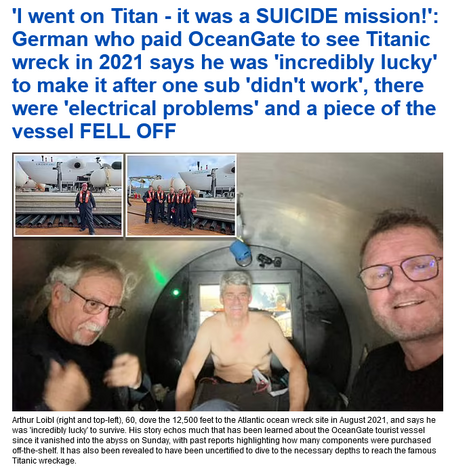
This was effectively one step above literally going to Lowes and getting some metal garbage cans and duct tape, then wrapping up the cans with the tape.
So How Did It Break?
—Stockton Rush, and man who is still alive today because of the rules he safely broken. | ||
—Stockton Rush, a man who will be remembered for the rules he broke. | ||

Simple: the designer—Stockton Rush—was an idiot who thought they could outsmart the laws of physics, and also surrounded himself with yesmen. But if you want to get into the nitty gritty of it:
- the use of Carbon fiber in-and-of-itself ultimately doomed it. Carbon fiber is useful to CONTAIN a larger pressure inside from a weaker pressure outside. It's awful the otherway around. And specifically for the Titan, it ended up being the point of failure as it was subjected to fatigue and micro-cracks after repeatedly subjecting it to extreme pressures. Even Starbucks baristas can handle pressure better than that sub.
- ignoring the warning sensors: the Titan was built with a number of acoustic and strain sensors to tell the occupants that "hey, something cracked/flexed and it might not be a good thing!". In fact, on dive 80 there was a HUGE pop that everyone heard. What was Stockton's response? "Awww it'll be fine!" and promptly ignored it. He ignored the thing was was installed to WARN HIM ABOUT PROBLEMS
- the precise point of failure ultimately came from the front end of sub—around the interface between the titanium hemispheres and the carbon fiber hull—as the hull fractured and pushed the front half towards the back, all due to the aforementioned fatigue and micro-cracks. Proof once again that crack kills.
- as one might guess, the implosion occured almost instantaneously, ensuring everyone got turned into pink mist before they realized they were pink mist.
- another serious factor in its eventual demise is the fact that it was designed NOT as a single piece, but one that mixed different materials together, and thus have different elastic deformation rates under uniform compression. In other words: making a submarine that is half-titanium and half-carbon fiber is about as effective as if it was half-titanium and half-cake.
- other contributing factors include:
- the type of adhesive used to bond the titanium and carbon fiber sections
- issues with how the carbon fiber itself was manufactured and tested
- other subpar materials and procedures might have been involved during construction
- naming the submersible "Titan", the latest in a line of ships of the same/similar name known for their ability to survive the test of time, designed by people who had absolutely no hubris whatsoever.
- oh, and firing the one guy at your company who was sounding the alarm that things kinda suck and might be dangerous
In October 2024, footage from the recovery of the OceanGate Titan submersible was finally released, and it proved everything we knew about it: it sank.
-
the pointy back end survived, so that's a plus
-
close up of the pointy back thing
-
detail of the main submersible; the top of the submersible is facing towards the seafloor, and the port-side is facing the camera
-
debris field is 1600 chad freedom units (or about 500 virgin meters) away from the Titanic
At least the titanium hemispheres survived... maybe use them next time?
So if you want to start up YOUR own Titanic-bound submersible company and actually survive a trip down:
- don't use carbon fiber
- don't design the sub as a cylinder
- don't use subpar materials during construction
- don't build your sub using multiple parts and instead make it out of a single piece
- don't ignore the warning sensors you installed to warn you that something bad just happened
- don't assume that "it survived this time, it'll survive the next one!" and instead actually inspect the sub after each dive
- don't fire the guy who is warning you that shit's sus
- don't name your ship after the Titanic
Now What?

Well, OceanGate is basically sitting and waiting for the unisex hammer of justice to drop on them.
Gallery
Videos
Previous Video | Next Video |
In conclusion
You will never be a real submarine.
You have no pressure hull, you have no ballast tanks, you have no torpedoes.
You are a drainage pipe twisted by carbon fiber and acrylic into a crude mockery of nature’s perfection.
You will always be a submersible.
See also
| Article of the Now June 28 & June 29, 2023 | ||
| Preceded by Dextromethorphan |
OceanGate | Succeeded by Futurama |
